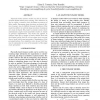Free Online Productivity Tools
i2Speak
i2Symbol
i2OCR
iTex2Img
iWeb2Print
iWeb2Shot
i2Type
iPdf2Split
iPdf2Merge
i2Bopomofo
i2Arabic
i2Style
i2Image
i2PDF
iLatex2Rtf
Sci2ools
82
Voted
ICIP
2005
IEEE
2005
IEEE
A weight-adaptive dynamic model for shape segmentation
Physically based dynamic models are able to describe variable shapes without prior training. Their behaviour to find an object is intuitive, which facilitates corrections of false results. Expressing shape variation as physical feature, however, may be difficult because the physics of the model has little to do with the shape variation of instances of a class of objects. We present a dynamic model, which automatically adapts model parameters based on results of previous segmentations. The model was applied to artificial data and to images of leaves. Results show that the adapted model finds the correct shape more accurate than a model with preset parameters. Investigation of the parameterisation from adaptation also showed that they may be interpreted in terms of the semantics of the shape class represented.
Related Content
| Added | 23 Oct 2009 |
| Updated | 14 Nov 2009 |
| Type | Conference |
| Year | 2005 |
| Where | ICIP |
| Authors | Klaus D. Tönnies, Peter Benedix |
Comments (0)

